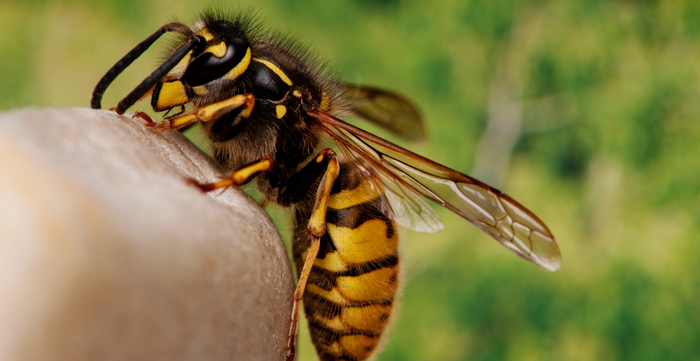Key points
- Approximately two million Americans have an allergy to insect stings, which can cause severe reactions.
- Mild reactions to bee stings usually result in redness, itching, and swelling at the site of the sting.
- Severe allergic reactions can lead to anaphylactic shock, which requires immediate medical attention.
- Minor stings can be treated at home, but severe reactions require professional medical care, possibly including the use of an EpiPen.
- Prevention is key to avoiding stings, and it is recommended to check outdoor areas for nests before engaging in activities. If you have had past bee sting symptoms or have asthma, it's important to see a doctor even if the initial reaction seems mild.

1. Mild Reactions
Many of us will only experience a mild reaction to bee strings where the bite site becomes red, itchy and swollen. The use of antihistamines and hydrocortisone cream usually relieves these symptoms and a cool ice pack will help with swelling. However, there are more severe reactions that may require a trip to an urgent care center.
2. Allergic Reactions
If a person is allergic to bees, wasps or hornets, and they are stung, it is possible the individual will go into anaphylactic shock and require immediate family medical care. According to WebMD, some of the symptoms to watch for that can lead to anaphylactic shock include:
- Trouble breathing and/or swallowing
- Immediate swelling around the eyes, tongue, lips or throat
- Severe itching
- Wheezing or becoming hoarse
- Dizziness or lightheadedness
- A rash or hives
- Stomach cramps or nausea
- Diarrhea
- Total loss of consciousness
- Confusion or panic
3. Treating Minor Stings
For most of us, it's pretty easy to treat minor stings. Steps include:
- Removal of the stinger with tweezers or a fingernail
- Washing the area with water and soap
- Cold compresses on the affected area
If a person is stung repeatedly and do not suffer any of the severe reaction signs, the above steps should be completed. However, additional treatment includes:
- Hydrocortisone cream applied directly on the area
- Antihistamines that contain diphenhydramine (Benadryl) or chlorpheniramine (Chor-Trimeton).
- Avoid the urge to scratch the affected area as this may cause an infection. Calamine lotion is helpful to alleviate itching urges.
4. Treating Severe Allergic Reactions
If a person has been stung by a bee and knows they are allergic, family care doctors can prescribe EpiPens that contain epinephrine to prevent an attack from becoming severe.
The Boston Children's Medical Hospital says about three percent of children are allergic to bee stings and if a severe reaction occurs, do seek out a pediatric urgent care center even if you have utilized epinephrine. Keep in mind epinephrine only reduces the reaction, and you may need further care.
If you seek urgent care, treatment includes:
- The use of oxygen to help the patient breathe
- Additional epinephrine if needed
- CPR if the individual stops breathing or the heart isn't beating
- Antihistamines and cortisone via IV delivery
- A beta agonist or breathing treatment that contains albuterol
It's also important to note when it's time to see a doctor even if initially, the area doesn't swell. See a doctor if:
- Redness or swelling doesn't decrease within three days
- If you have asthma or another type of breathing problem
- You're stung in multiple places or fear it was an Africanized bee sting
- You have had past bee sting symptoms that caused even a small reaction
Prevention is also a great way to avoid being stung. Before engaging in outdoor activities or allowing your children to play outside, check the surrounding area for bee or wasp nests and call an exterminator to help remove these nests.
FAQs
How can I tell if I'm having an allergic reaction to a bee sting?
Symptoms of an allergic reaction include trouble breathing, severe itching, swelling around the eyes, tongue, lips or throat, and dizziness.
What should I do if I get stung by a bee?
For minor stings, remove the stinger, wash the area with soap and water, and apply a cold compress. If you experience severe symptoms, seek immediate medical attention.
What is the treatment for severe allergic reactions to bee stings?
Treatment includes the use of oxygen, additional epinephrine if needed, CPR if necessary, antihistamines and cortisone via IV, and a breathing treatment that contains albuterol.
When should I see a doctor after a bee sting?
You should see a doctor if redness or swelling doesn't decrease within three days, if you have asthma or another type of breathing problem, if you're stung in multiple places, or if you've had past bee sting symptoms that caused even a small reaction.
How can I prevent bee stings?
Before engaging in outdoor activities, check the surrounding area for bee or wasp nests and call an exterminator to help remove these nests.
What can be done to prevent bee stings?
Prevention methods can include checking the surrounding area for bee or wasp nests before engaging in outdoor activities or allowing children to play outside, and calling an exterminator to help remove these nests.
What is anaphylactic shock?
Anaphylactic shock is a severe and potentially life-threatening allergic reaction that can occur in individuals allergic to bees, wasps, or hornets. It requires immediate medical care.
What is the role of an EpiPen in treating severe allergic reactions to bee stings?
An EpiPen contains epinephrine, which can prevent an allergic reaction from becoming severe. It's typically prescribed by family care doctors to individuals known to be allergic to bee stings.

